What is Design? And What is not?
Defining design evolves from its characteristics and how it is distinguished from other disciplines such as engineering, business or even marketing. In several events, I’ve been asked about the design thinking process and why it is different from other processes, such as the stage-gate innovation process. The core answer to this question dwells in the nature of design itself. Sadly, many designers and even users of the design thinking process, as Cross (2011) highlighted, find it challenging to describe the cognitive process of designing a product. They can describe what they are designing but not how especially at the ideation stage and form their perception about the product or service they are designing. As a result of this inability, designers may apply the unique value of design unconsciously since they have a higher design ability than others.
Related articles:
- The Double Diamond Design Thinking Process and How to Use it
- Jumping into Design Thinking? Read These Books First
- Design Thinking Guide: What, Why and How
This article aims to explore what design is from the perspective of its characteristics and not the dictionary definition. Understanding what is design and what is not helps identify its borders and distinguish it from other disciplines. Let us start by exploring what design characteristics are not considered to eliminate part of the misunderstanding about design characteristics (How Inclusive Design Reshaped Microsoft Products).
What is not Design?
The misleading concepts related to design is driven by the deceptive words used to describe the design practice and the design process. I decided to start with what design isn’t to eliminate this confusion about our perception of the design practice:
Design isn’t Linear
The main problem with several design thinking models nowadays is that they imply that the design process is linear, which is wrong because designers jump from one step to another without specific ordeal progress in actual practice. As a designer myself, I found it difficult to map a particular routine of my design practice. This unclarity becomes more complicated when you observe the practice over several projects. For example, you can use the client feedback from one task to jump directly to the prototyping in another project. Sometimes, the client dictates specific needs that limit the designers’ divergent thinking. The updated version for the Double Diamond added this non-linear nature of design (Figure 1).
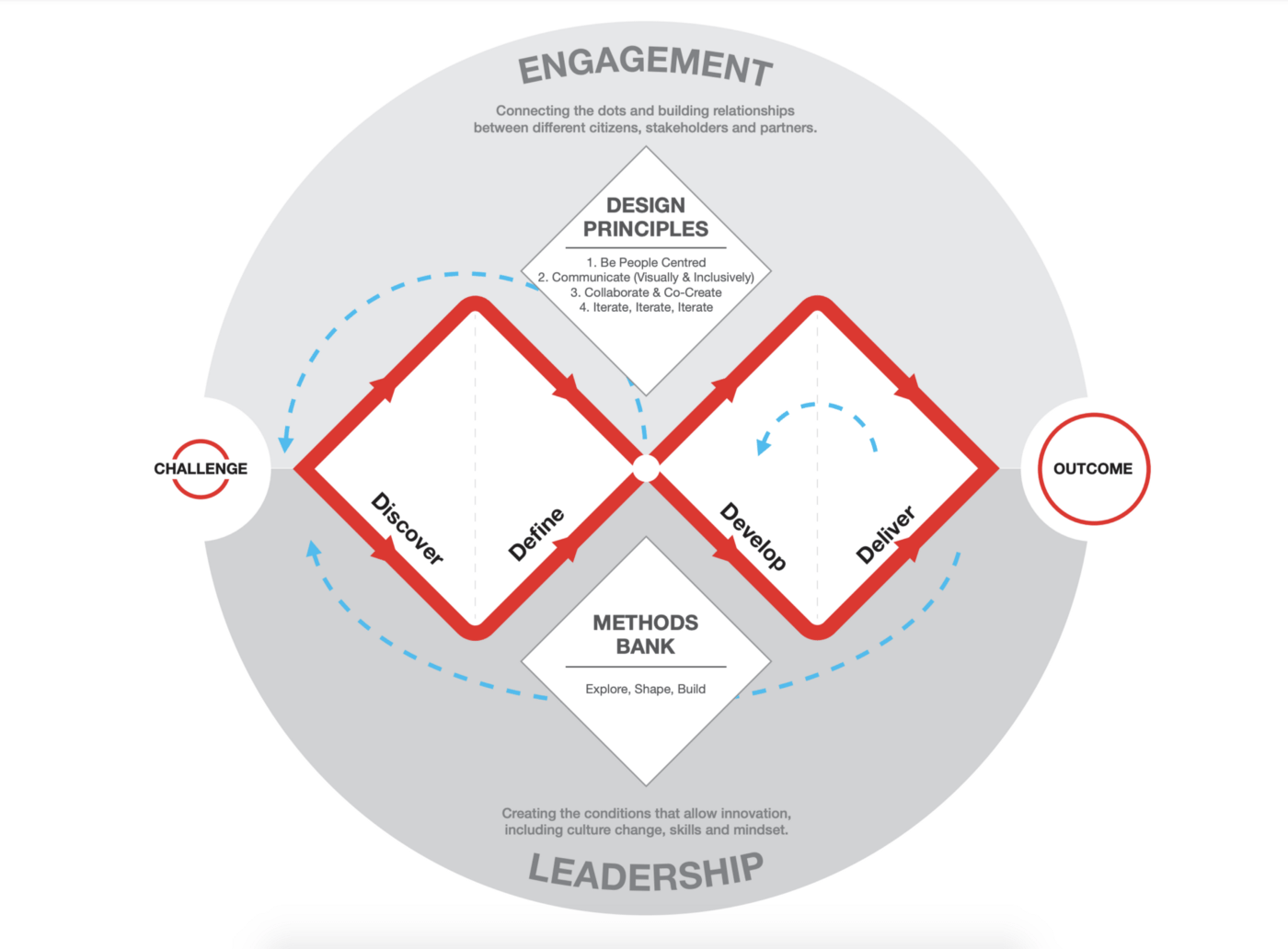
Dorst (2009) highlighted the term” arena”, reflecting a more accurate description of the design practice because it allows the mind to escape the idea of a fixed sequential progression of stages. I still use the word “process” to avoid confusion, especially when discussing design thinking.
Problems are not Problems.
While I, myself, used the word “problem” in several articles. We must clearly understand that the term “problem” is the opposite of “solution”. Those terms should only describe the situation in relation to a particular point in time. For example, the usage of plastics. At a specific point in history, plastics were a solution as a cheap, affordable, flexible material. However, this solution turned out to become our major problem today. Ford’s invention of affordable cars solved the major problem of using horses in crowded cities such as New York. These cars have become a major pollution contributor due to carbon emissions. Yesterday’s solutions are own today’s problems, and today’s solutions can turn out to be tomorrow’s problems.
In one of my conversations with Dr Heliana Pacheco, Wrexham Glyndwr University, and Dr Stuart English, Northumbria University, Dr Heliana rejected the idea of the word problem replacing it with the word “issue”. Dr Stuart used the word “situation” to describe such events. We had an agreement that the term “ill-situation” could be more suitable to describe the state before the designer’s intervention in the situation.
In this article, I will continue to use the word “problem” to avoid confusion for the readers. However, its definition is altered to reflect the nature of “an ill situation”.
There are no Ultimate Solutions.
One of the main stages of the design thinking process is prototyping. If you worked as a design practitioner, you would appreciate the value of prototyping and testing in reaching a mature product level. However, this is not the journey’s end, as the design factors change as technology advances. User behaviour changes in response to these expectations. The development of face recognition provided a better user experience to unlock their phones quickly. Electric cars are a breakthrough innovation that responds to consumer and environmental needs. Dorst (2015) highlighted describing the design practice as we move from one situation to an improved one. It is a continuous cycle of improvement, a dynamic one.
What is Design?
Design characteristics allow us to identify its contribution to the development of products and services. It highlights the unique value of applying design and the outcome of this application. To this goal, I mapped the different scholars who tried to identify these characteristics and link between points of view (see Figure 2).
Design is User-Centred and inclusive (Cross, 1994; Brown & Katz, 2011)
The designer aims to address people’s needs and improve their lives. This aim forms the whole design process, including users’ involvement to understand their unmet and unidentified needs. The design practice involves co-creation and working with users and partners to create a testable product. Research methods at the beginning of the process aim to explore the real user needs and the root cause of problems, which formulates a clear definition of the problem or the target needs of the users. Then, the prototyping stage allows these findings to be tested with users to improve them.
Design is Reflective Practice (Schön, 1985; Simon, 1968)
The design practice is based on the reflective practice’s four stages (plan, act, observe and reflect). You probably relate those four stages to the different design thinking models that usually use those stages or inspire the design practice. As a designer, these four stages present my practice when working on a design project:
- Research the problem, identify its dimensions and explore it with users.
- Create the prototypes that the client will see. The designers observe user behaviour through testing and evaluation.
- Use the feedback to improve the product.
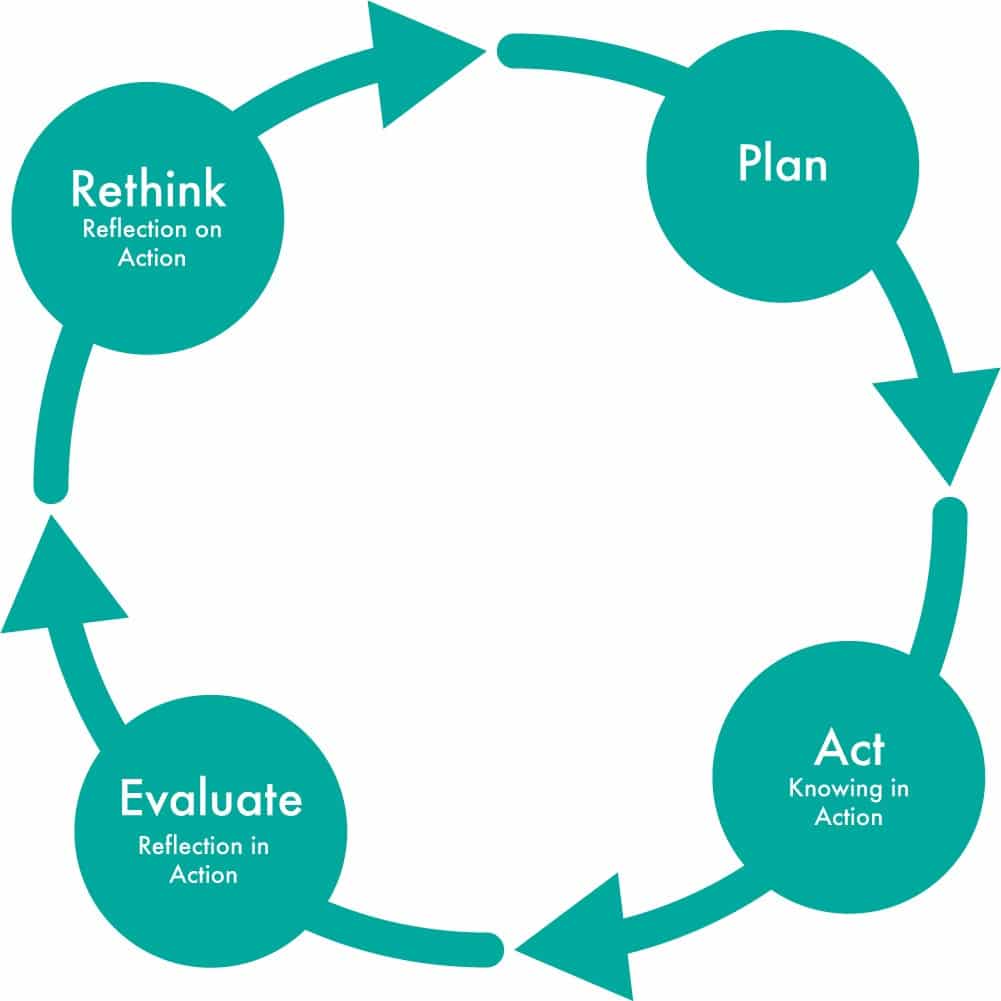
Schön addressed this practice as ‘a reflective process’ or ‘a reflective conversation with the situation (Cross, 2011. p.56).
‘The proper study of mankind is the science of design, not only as the professional component of a technical education but as a core discipline for every liberally educated man’ (Simon, 1968, p.83).
Problem-Solving (Cross, 2011; Shcön, 1985)
While investigating ideas and moving through the design thinking process stages, designers clearly define the problem and its root causes. Based on the Double Diamond design thinking, the second stage, Define, provides a clear definition of the problem; this clarity is tested using the Develop stage. If the Develop stage concludes that the problem is not appropriately defined, designers could return to the first two stages, Discover and Define, to refine the problem. This iterative reflective practice process drives the team toward identifying the problem solutions.
‘The old centre of the universe was the mind knowing by means of an equipment of powers complete within itself, and merely exercised upon an antecedent external material equally complete within itself. In this new centre is indefinite interactions taking place within a course of nature which is not fixed and complete, but which is capable of direction to new and different results through the mediation of intentional operations.’ (Dewey, 1960, p.91).
Design is Creative (Brown & Katz, 2011; Cross, 2011; Dorst, 2015; Kimbell, 2011; 2012)
The aspect of creativity in design resides in the early divergent stage, where designers look for inspiration, ideas and opportunities. In this early stage, all opinions and solutions are discussed and included, considering the user needs, which require a slightly different type of creativity than perceived in arts. In design, creativity connects various factors and produces ideas that connect aesthetics, function, user-friend, accessibility, discoverability, error prevention, and related factors. While Cross (2011) and Kimbell (2011; 2012) highlighted that we all have design skills, some are more designers than others. Kimbell defined designers as part of the creative class. In the video below, Tim Brown, IDEO founder, explore the creativity in design thinking.
Another driver of creativity in the design process is acknowledging uncertainty and ambiguity. The expansion of ideas and disconnection between them creates a period of uncertainty and ambiguity where the ideas form by connecting the elements of the problem. This nature supports the creative practice highlighted above.
Design Iteration and Prototyping
Design iteration aims to build various prototypes for the product test, share and get feedback to improve it and ensure that the main aim (user-centric product or service) is achieved in the delivered product. This continuous loop of feedback and iteration maintains the product’s improvement in the future and addresses user challenges. Design iteration can be liked to the above characteristics, such as user-centred practice. The involvement of the user in co-create practice and testing produces multiple iteration rounds. The reflective practise aims to observe the product used and implemented, get feedback and apply use this feedback to improve the product. Many companies don’t take advantage of the co-create practice, reducing modification rounds in the prototyping and testing stage.
The design iteration aspect discussed below is another driver of creativity, as testing and exploring different materials and solutions can support the creative practice. Design iteration can help designers to test the human and business factors. The video below from the James Dyson Foundation about iterative design as part of the design engineer’s main characteristics:
Design is a unique practice. It merges rational scientific knowledge and initiative creative skills. While many designers can describe what they are doing, they find it challenging to define design. Identifying this nature allows us to understand design contribution and added value in professional practice. This article explored design borders and how these characteristics can add value to a business.
References:
Brown, T., & Katz, B. (2011). Change by design. Journal Of Product Innovation Management, 28(3), 381–383.
Cross, N. (1997). Descriptive models of creative design: Application to an example. Design Studies, 18(4), 427–440.
Cross, N. (2011). Design thinking: Understanding how designers think and work. Oxford: Berg.
Dorst, K. (2011). The core of ‘design thinking’ and its application. Design Studies. doi: 10.1016/j.destud.2011.07.006.
Dorst, K. (2015). Frame innovation: Create new thinking by design. Cambridge: MIT Press.
Dorst, K., & Cross, N. (2001). Creativity in the design process: Co-evolution of problem–solution. Design studies, 22(5), 425–437.
Kimbell, L. (2011). Rethinking design thinking: Part I. Design and Culture, 3(3), 285–306.
Kimbell, L. (2012). Rethinking design thinking: Part II. Design and Culture, 4(2), 129–148.
Schön, D. A. (1983). The reflective practitioner how professionals think in action. Basic Books: New York.
Schön, D. A. (1987). Educating the Reflective Practitioner. San Francisco: Jossey- Bass. Pediatrics.
Simon, H. (1968). The sciences of the artificial. Cambridge: M.I.T. Press
Quick Revision
here are several definitions of design. In Figure 2, these definitions were mapped to identify design characters. These are creative, uncertain, iterative, problem-solving, and user needs. In general, the design is the practice, process and strategy to address user needs and problems with creative and innovative solutions.
To identify the design practice, we need to eliminate the misleading concepts about design. These design myths are 1) design isn’t linear (it is circular like arena), 2) problems are not problems (they are ill situations), 3) there are no ultimate solutions (only improved state)

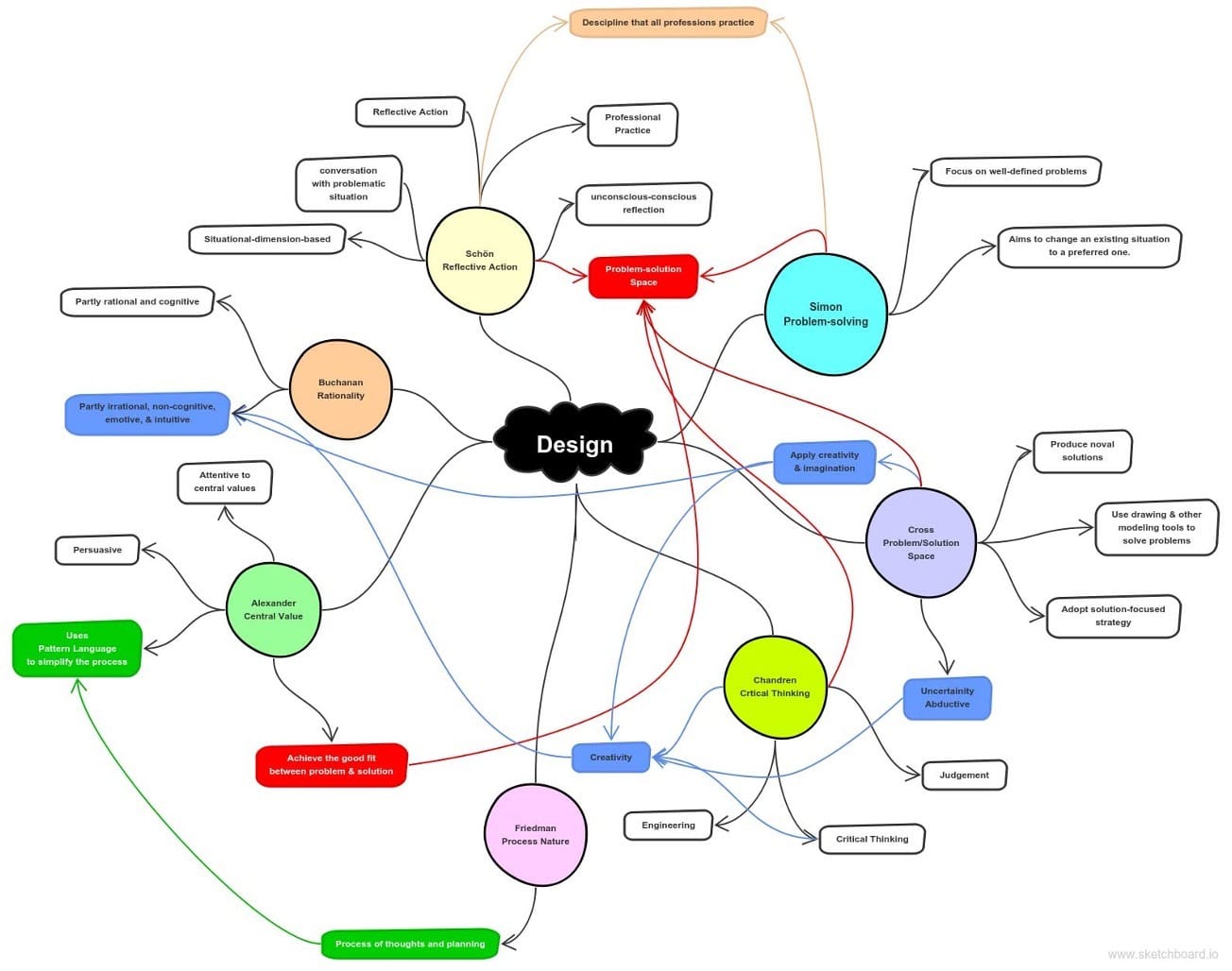
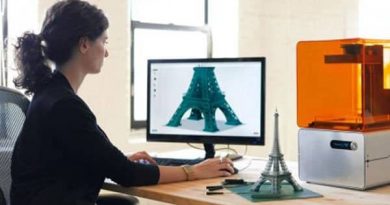



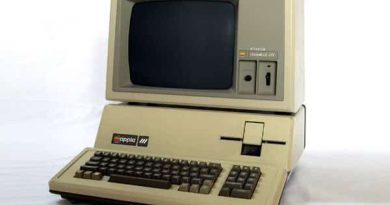

So, how is design distinguished from other disciplines such as engineering, business or even marketing?
I’m most courious about difference between design and engineering.
Dear David, the main aspect is the discipline approach. While engineering focuses on the science and its applications, design focuses on human needs and adopt the business and the technology toward meeting their. Think of the Symbian OS and the iOS. While the old Symbian system was very well engineered, it didn’t focus on user experience comparing to iPhone iOS. The same concept is applied in business and marketing. Before applying design as a driver of innovation, the marketing and business focused on increasing the ROI, which many companies still do. I hope this answered your question and I would be glad to hear your thoughts.